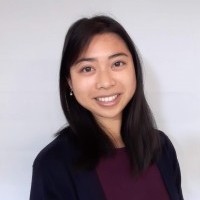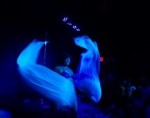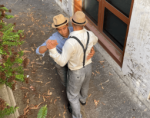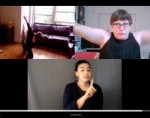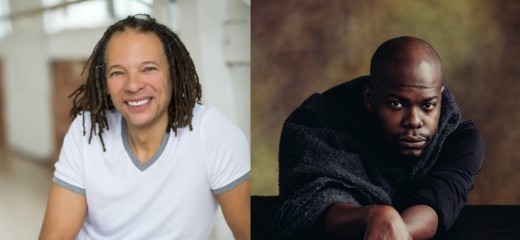
thomas defrantz and Jaamil Olawale Kosoko at Moving Bodies, Social Justice
by Kara Nepomuceno
As artists, educators, and divine spirits, thomas defrantz and Jaamil Olawale Kosoko are adjacent streams in the landscape of dance. In 2018, they collaboratively taught at Movement Research and presented at a series hosted by University of the Arts. This April, their paths ran parallel again, each guiding a 90-minute virtual workshop in the final session of the Moving Bodies, Social Justice symposium, a collaboration between the dance departments of the Five Colleges of Ohio.
defrantz’s workshop, “Making*Queering*Dancing,” began with a “willingness to undo the assumptions thrown at us;” particularly preconceived notions about Zoom workshops. defrantz switched between three cameras: the first capturing a broad view of the studio and defrantz’s figure, far below; the second about ten feet from his body; the third a built-in monitor camera.
By allowing us to see defrantz at face-level, as well as above, behind, and beside his body, I perceived and engaged the virtual space differently. “It’s hard to queer Zoom, but I try all the time.” He smiled, the camera shifting far above him.
defrantz invited us to “explore queer possibilities as ancestor-worship.” He asked us to bring in “queer kin,” throwing his hand behind him as if welcoming a friend. Through practices of vibrating with queer kin, desiring (“What do you want?”), and feeling (“How do you feel? How do you know what you feel?”), each prompt built intuitively on the last. “Let’s try,” he said casually, as he invoked systems of kinship, desire, and imagination. Though uncertain, I felt emboldened to try, to vibrate towards the possibilities of “queer|making|dancing.”
The effort and power of embodied imagination were shared commitments in Kosoko’s “The Transgressive Body Workshop.” Perhaps inspired by the “The Hold,” the vocal piece which opens his most recent work American Chameleon, Kosoko began by inviting us to lie down and find stillness, holding our bodies “in all [their] complexity.” He crossed his arms over his chest, and pressed his hands lightly over cheeks and eyes. A moment to behold “the transgressive body.”
Kosoko cued us to find where it hurts and allow grief to move us, returning every so often to the breath. My hands drew immediately above the heart. He suggested that moving grief through the body was a special practice, one that also “mov[es] energy through the body, mov[es] power through the body.” He spoke of grief as both tear and flood, a “hydraulics of grief.” This pressure became “a fluid, transformative transfer of power” that warmed me.
In both workshops, voice and song seemed to pour from the screen into my body, transferring energy, sending vibrations from their room to mine. Black scholarship and aurality was lovingly cited. From a playlist Kosoko entitled “Syllabus for Black Love,” we danced to Nina Simone and Grace Jones, among others. Prompts drew from Black scholars (Saidiya Hartman, Audre Lorde, Christine Sharpe) and musicians (Big Freedia, OutKast). Introducing a vocal performance from collaborator mayfield brooks, Kosoko remarked on the power of voice: “A voice can move beyond, through time. It reaches back, it reaches forward.”
Many of us have raised our voices this year, whether online or in the streets. Some have experienced solace, and others frustration, conducting our lives over Zoom. It can be easy to become numb. defrantz has proposed a different technology, “the technology of dance, [which] is quite amazing …[as] a technology that encourages us to feel… And what a thing,” he added, “to have a technology available that registers feeling as an achievement.”
He proved this to be true. Through stories, questions, and gentle reminders, Kosoko and defrantz crafted Black queer technologies for sonic guidance across distance. They drew me close again to my feelings, those powerful hydraulics shifting just beneath the skin.
Moving Bodies was funded by the Ohio 5 Collaborative Grant and the Dance Departments of Oberlin, Wooster, Kenyon, Denison, and Ohio Wesleyan University, as well as the Gender, Sexuality, and Feminist Studies and Title IX programs at Oberlin. The series investigated “Kinethics,” “Body Positivity: Radical Self Love and Social Transformation,” and “Queer Kinethics.” From February to April, the symposia included lectures, artist talks, and discussions from Naomi Macalald Bragin, mayfield brooks, Sydnie L. Moseley, Sharon Udoh, Clare Croft, and Kareem Khubchandani.
*The author is an alumnus of the Oberlin College Dance Department.
Making*Queering*Dancing, thomas f. defrantz, Moving Bodies Social Justice Symposium, April 15th, 2021.
The Transgressive Body Workshop, Jaamil Olawale Kosoko, Moving Bodies Social Justice Symposium, April 22nd, 2021.
By Kara Nepomuceno
April 28, 2021

